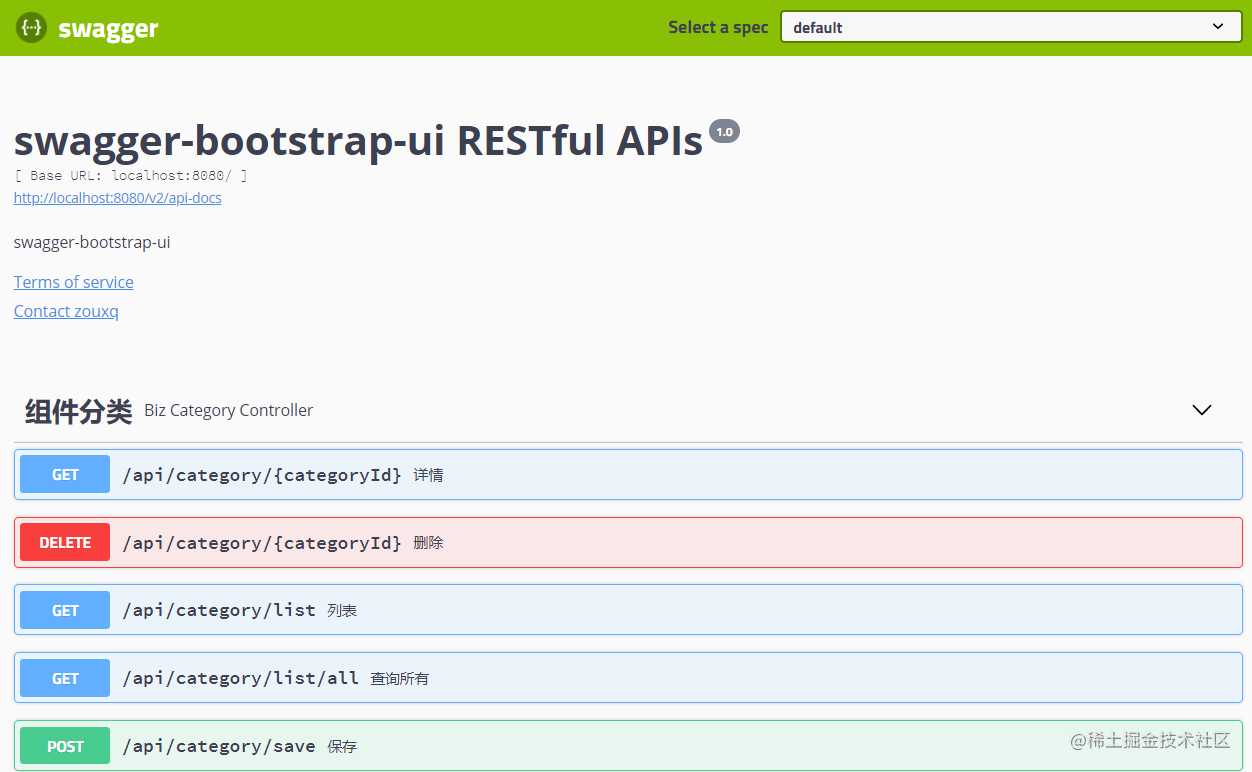介绍
什么是Swagger
Swagger是一个规范和完整的框架,用于生成、描述、调用和可视化 RESTful 风格的 Web 服务。总体目标是使客户端和文件系统作为服务器以同样的速度来更新。文件的方法,参数和模型紧密集成到服务器端的代码,允许API来始终保持同步。
作用
- 接口文档在线自动生成
- 功能测试
Swagger是一组开源项目,其中主要要项目如下:
-
Swagger-tools:提供各种与Swagger进行集成和交互的工具。例如模式检验、Swagger 1.2文档转换成Swagger 2.0文档等功能。
-
Swagger-core: 用于Java/Scala的的Swagger实现。与JAX-RS(Jersey、Resteasy、CXF…)、Servlets和Play框架进行集成。
-
Swagger-js: 用于JavaScript的Swagger实现。
-
Swagger-node-express: Swagger模块,用于node.js的Express web应用框架。
-
Swagger-ui:一个无依赖的HTML、JS和CSS集合,可以为Swagger兼容API动态生成优雅文档。
-
Swagger-codegen:一个模板驱动引擎,通过分析用户Swagger资源声明以各种语言生成客户端代码。
在Spring使用Swagger
在Spring中集成Swagger会使用到springfox-swagger,它对Spring和Swagger的使用进行了整合
<dependency>
<groupId>io.springfox</groupId>
<artifactId>springfox-swagger2</artifactId>
<version>${springfox.swagger.version}</version>
</dependency>
<dependency>
<groupId>io.springfox</groupId>
<artifactId>springfox-swagger-ui</artifactId>
<version>${springfox.swagger.version}</version>
</dependency>
使用
Spring中配置Swagger
/** * Swagger2配置类 * 在与spring boot集成时,放在与Application.java同级的目录下。 * 或者通过 @Import 导入配置 */
@Configuration
@EnableSwagger2
public class Swagger2 {
/** * 创建API应用 * apiInfo() 增加API相关信息 * 通过select()函数返回一个ApiSelectorBuilder实例,用来控制哪些接口暴露给Swagger来展现, * 本例采用指定扫描的包路径来定义指定要建立API的目录。 * @return */
@Bean
public Docket createRestApi() {
return new Docket(DocumentationType.SWAGGER_2)
.apiInfo(apiInfo())
.select()
.apis(RequestHandlerSelectors.basePackage("com.turbo.demo.controller"))
.paths(PathSelectors.any())
.build();
}
/** * 创建该API的基本信息(这些基本信息会展现在文档页面中) * 访问地址:http://项目实际地址/swagger-ui.html * @return */
private ApiInfo apiInfo() {
return new ApiInfoBuilder()
.title("Spring Boot中使用Swagger2构建RESTful APIs")
.description("")
.termsOfServiceUrl("")
.contact("zou", "", "zouxq412@foxmail.com")
.version("1.0")
.build();
}
}
API注解
@Api
用在类上,该注解将一个Controller(Class)标注为一个swagger资源(API)。在默认情况下,Swagger-Core只会扫描解析具有@Api注解的类,而会自动忽略其他类别资源(JAX-RS endpoints,Servlets等等)的注解。该注解包含以下几个重要属性
- tags API分组标签。具有相同标签的API将会被归并在一组内展示。
- value 如果tags没有定义,value将作为Api的tags使用
- description API的详细描述,在1.5.X版本之后不再使用,但实际发现在2.0.0版本中仍然可以使用
@ApiOperation
在指定的(路由)路径上,对一个操作或HTTP方法进行描述。具有相同路径的不同操作会被归组为同一个操作对象。不同的HTTP请求方法及路径组合构成一个唯一操作。此注解的属性有:
- value 对操作的简单说明,长度为120个字母,60个汉字。
- notes 对操作的详细说明。
- httpMethod HTTP请求的动作名,可选值有:”GET”, “HEAD”, “POST”, “PUT”, “DELETE”, “OPTIONS” and “PATCH”。
- code 默认为200,有效值必须符合标准的HTTP Status Code Definitions。
@ApiImplicitParams
用在方法上,注解ApiImplicitParam的容器类,以数组方式存储。
@ApiImplicitParam
对API的单一参数进行注解。虽然注解@ApiParam同JAX-RS参数相绑定,但这个@ApiImplicitParam注解可以以统一的方式定义参数列表,也是在Servelet及非JAX-RS环境下,唯一的方式参数定义方式。注意这个注解@ApiImplicitParam必须被包含在注解@ApiImplicitParams之内。可以设置以下重要参数属性:
- name 参数名称
- value 参数的简短描述
- required 是否为必传参数
- dataType 参数类型,可以为类名,也可以为基本类型(String,int、boolean等)
- paramType 参数的传入(请求)类型,可选的值有path, query, body, header or form。
@ApiParam
增加对参数的元信息说明。这个注解只能被使用在JAX-RS 1.x/2.x的综合环境下。其主要的属性有
- required 是否为必传参数,默认为false
- value 参数简短说明
@ApiResponses
注解@ApiResponse的包装类,数组结构。即使需要使用一个@ApiResponse注解,也需要将@ApiResponse注解包含在注解@ApiResponses内。
@ApiResponse
描述一个操作可能的返回结果。当REST API请求发生时,这个注解可用于描述所有可能的成功与错误码。可以用,也可以不用这个注解去描述操作的返回类型,但成功操作的返回类型必须在@ApiOperation中定义。如果API具有不同的返回类型,那么需要分别定义返回值,并将返回类型进行关联。但Swagger不支持同一返回码,多种返回类型的注解。注意:这个注解必须被包含在@ApiResponses注解中。
- code HTTP请求返回码。有效值必须符合标准的HTTP Status Code Definitions。
- message 更加易于理解的文本消息
- response 返回类型信息,必须使用完全限定类名,比如“com.xyz.cc.Person.class”。
- responseContainer 如果返回类型为容器类型,可以设置相应的值。有效值为 “List”, “Set” or “Map”,其他任何无效的值都会被忽略。
Model注解
对于Model的注解,Swagger提供了两个:@ApiModel及@ApiModelProperty,分别用以描述Model及Model内的属性。
@ApiModel
描述一个Model的信息(一般用在请求参数无法使用@ApiImplicitParam注解进行描述的时候)
提供对Swagger model额外信息的描述。在标注@ApiOperation注解的操作内,所有的类将自动被内省(introspected),但利用这个注解可以做一些更加详细的model结构说明。主要属性有:
- value model的别名,默认为类名
- description model的详细描述
@ApiModelProperty
描述一个model的属性
对model属性的注解,主要的属性值有:
- value 属性简短描述
- example 属性的示例值
- required 是否为必须值
注解示例
Api 示例
@AllArgsConstructor
@RestController
@RequestMapping("/api/category")
@Api(value = "/category", tags = "组件分类")
public class BizCategoryController {
private IBizCategoryService bizCategoryService;
@GetMapping("/list")
@ApiOperation(value = "列表", notes = "分页列表")
public R<PageModel<BizCategory>> list(PageQuery pageQuery,
@RequestParam @ApiParam("组件分类名称") String name) {
IPage<BizCategory> page = bizCategoryService.page(pageQuery.loadPage(),
new LambdaQueryWrapper<BizCategory>().like(BizCategory::getName, name));
return R.success(page);
}
@GetMapping("/list/all")
@ApiOperation(value = "查询所有", notes = "分页列表")
public R<List<BizCategory>> listAll() {
List<BizCategory> categories = bizCategoryService.list();
return R.success(categories);
}
@GetMapping("/{categoryId}")
@ApiOperation(value = "详情", notes = "组件分类详情")
public R<BizCategory> detail(@PathVariable @ApiParam("分类Id") Long categoryId) {
BizCategory category = bizCategoryService.getById(categoryId);
return R.success(category);
}
@PostMapping("/save")
@ApiOperation(value = "保存", notes = "新增或修改")
@ApiImplicitParams({
@ApiImplicitParam(paramType = "form", name = "categoryId", value = "组件id(修改时为必填)"),
@ApiImplicitParam(paramType = "form", name = "name", value = "组件分类名称", required = true)
})
public R<BizCategory> save(Long categoryId, String name) {
BizCategory category = new BizCategory();
category.setId(categoryId);
category.setName(name);
bizCategoryService.saveOrUpdate(category);
return R.success(category);
}
@DeleteMapping("/{categoryId}")
@ApiOperation(value = "删除", notes = "删除")
public R delete(@PathVariable @ApiParam("分类Id") Long categoryId) {
bizCategoryService.delete(categoryId);
return R.success();
}
}
ApiModel 示例
@Data
@EqualsAndHashCode(callSuper = false)
@Accessors(chain = true)
@ApiModel(value="BizComponent对象", description="组件")
public class BizComponent implements Serializable {
private static final long serialVersionUID = 1L;
@TableId(value = "id", type = IdType.AUTO)
private Long id;
@ApiModelProperty(value = "分类")
private Long categoryId;
@ApiModelProperty(value = "组件名称")
private String name;
@ApiModelProperty(value = "组件描述")
private String description;
@ApiModelProperty(value = "日期字段")
private LocalDateTime componentTime;
@ApiModelProperty(value = "创建时间")
@TableField(fill = FieldFill.INSERT)
private LocalDateTime createTime;
@ApiModelProperty(value = "修改时间")
@TableField(fill = FieldFill.INSERT_UPDATE)
private LocalDateTime modifiedTime;
}
swagger-ui界面
swagger生成的api文档信息接口为/v2/api-docs,不过我们可以使用ui界面更加清晰的查看文档说明,并且还能够在线调试
springfox-swagger-ui
<dependency>
<groupId>io.springfox</groupId>
<artifactId>springfox-swagger-ui</artifactId>
<version>${springfox.swagger.version}</version>
</dependency>
如果是使用springfox-swagger-ui,启动项目后的api文档访问路径是 /swagger-ui.html

swagger-bootstrap-ui
swagger-bootstrap-ui是springfox-swagger的增强UI实现,我个人更推荐使用这个ui,api文档结构更加清晰,在线调试也很方便
<dependency>
<groupId>com.github.xiaoymin</groupId>
<artifactId>swagger-bootstrap-ui</artifactId>
<version>${swagger.bootstrap.ui.version}</version>
</dependency>
访问的url为 /doc.html

Swagger分组
Swagger的分组接口是通过后端配置不同的扫描包,将后端的接口,按配置的扫描包基础属性响应给前端
后端java的配置如下,指定分组名和各自要扫描的包
@Bean(value = "defaultApi")
public Docket defaultApi() {
return new Docket(DocumentationType.SWAGGER_2)
.apiInfo(apiInfo())
.groupName("默认接口")
.select()
.apis(RequestHandlerSelectors.basePackage("com.example.demo.controller"))
.paths(PathSelectors.any())
.build();
}
@Bean(value = "groupApi")
public Docket groupRestApi() {
return new Docket(DocumentationType.SWAGGER_2)
.apiInfo(groupApiInfo())
.groupName("分组接口")
.select()
.apis(RequestHandlerSelectors.basePackage("com.example.demo.group"))
.paths(PathSelectors.any())
.build();
}
分组信息的接口为 /swagger-resources
[
{
"name": "分组接口",
"url": "/v2/api-docs?group=分组接口",
"swaggerVersion": "2.0",
"location": "/v2/api-docs?group=分组接口"
},{
"name": "默认接口",
"url": "/v2/api-docs?group=默认接口",
"swaggerVersion": "2.0",
"location": "/v2/api-docs?group=默认接口"
}
]
在swagger-ui中也可以通过分组来查看api文档

今天的文章Swagger使用和注释介绍分享到此就结束了,感谢您的阅读。
版权声明:本文内容由互联网用户自发贡献,该文观点仅代表作者本人。本站仅提供信息存储空间服务,不拥有所有权,不承担相关法律责任。如发现本站有涉嫌侵权/违法违规的内容, 请发送邮件至 举报,一经查实,本站将立刻删除。
如需转载请保留出处:https://bianchenghao.cn/19437.html
